As a social media pioneer, I have witnessed the power of content marketing and management for creative entrepreneurs.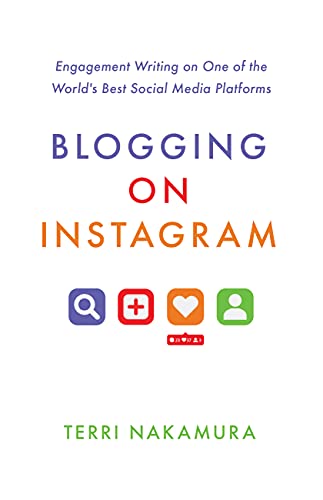
Content marketing is a budget-friendly way to market your creative efforts. Social media influencer and creative entrepreneur, Terri Nakamura has mastered the art of content marketing and management.
Terri’s popularity led her to write the recent best selling book, Blogging on Instagram. The book reveals how to craft images and captions to foster real interaction and how to grow a following while consistently delivering value to fans. It includes social media industry leaders and the voices of influencers who love using Instagram – I’m honored to be in Terri’s book!
A dynamo and an inspiration, Terri understands the balance between self-promotion, networking and giving back to her loyal online community. I’m honored to share her marketing wisdom with you.
Content Management and Management Tips for Creative Entrepreneurs

Many of us who work in creative professions need to promote ourselves or our businesses through social media.
Channels such as Facebook, Instagram, Pinterest, TikTok, or YouTube are where your customers and supporters live. In deciding where and when to share content, it’s essential to stay true to your brand and offer value to followers.
It’s hard to stay on top of everything. I’ve found content management tools and practices can help.
Content marketing and strategy
Before getting into tools, you need to lay the foundation. Randomly posting content will not help us get to where you want to go.
Content marketing is a strategic approach to creating and distributing content your audience will like. This is in contrast to the old ways of marketing where sales messages were pushed out to an audience. Today’s content marketing creates an affinity between your follower and your brand. It’s much more effective at getting consumers to take action.

But what is it, exactly?
Content marketing is the planning, collection, creation, and delivery of relevant information in any form. This includes videos, photos, captions, blog posts, newsletters, white papers, and curated (reshared) content created by others. Content marketing helps us shift the focus outward to our audiences.
Whether your goals include building awareness or attracting more followers, the posts on your social feeds should reinforce your brand and support your overall content strategy.
For creative entrepreneurs, the primary focus is sharing the art or content we create. It’s important to show what you have to offer and sometimes your creativity is enough to grow a community. But regardless, you want to convert viewers to fans and customers. Your posts should attract followers while forging connections with them. You can achieve this by sharing posts that entertain, inform, and educate.
I found a terrific overview explaining how to create a content marketing strategy. Click here to learn more about reaching your business goals through social content.
Management tools
The idea of content management isn’t top priority for many of us. But, if you periodically post, like, share, or make a comment, it’s better than nothing, right? That’s somewhat true, but it would be even better to share with purpose and intent.
Management tools provide an overview of what to share with your audiences. By choosing what to share and publishing posts strategically, your followers will understand your brand. Through anticipating posts, potential customers have time to make plans to attend a webinar, watch a live stream or check out other events, like a show or sale.
Planning content can be a complex task for a business that shares on multiple social media channels. A content or editorial calendar can be a big help. You can use it to plan when to share posts with audiences at specific times and will be able to see what’s coming down the pike.

Getting organized!
When assessing my client’s needs, I identify several categories that will provide interesting and relevant information to their followers.
There is an 80/20 golden rule for marketing on social media. It guides businesses to devote 20% directly promoting a business, but the bulk (80%) is geared to cultivating audience interest.
Content Calendars
A social media content calendar helps you plan to populate your feeds with engaging posts to your followers. It doesn’t have to be complex. In fact, if a tool looks too difficult or time-consuming, chances are you won’t use it.
A simple blank calendar where you can enter notations can work. Microsoft offers free calendar templates where you can make notations each day and Hubspot shared a post with a lot of options to consider.
Trust me when I say your calendar can be simple like the one above or more complicated. As an example, I’ve included some complex monthly and weekly business calendars below. Note how they are publishing to numerous channels at different intervals.
The following is a detailed content calendar outlining upcoming original content that will need to be created. This calendar includes schedules for publishing to Instagram, YouTube, white papers and newsletters. The calendar shows potential content categories and frequency for channels like Twitter and Facebook.
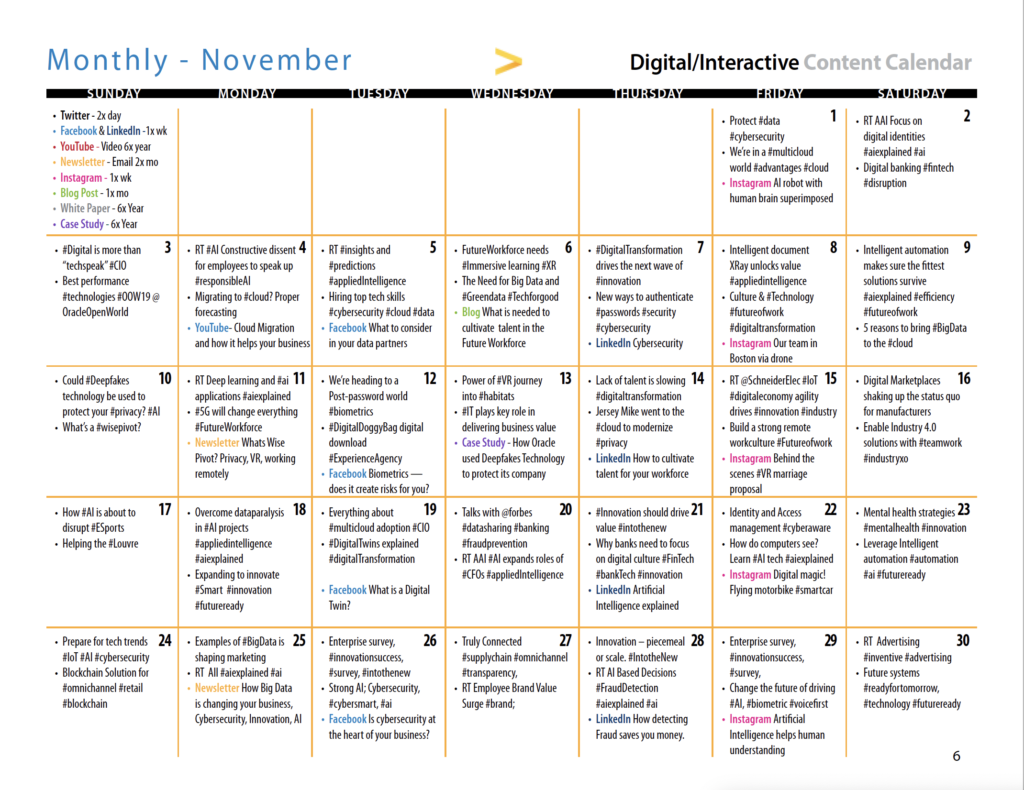
This monthly sample shows themes each week and the content that might be shared to reinforce the content themes.
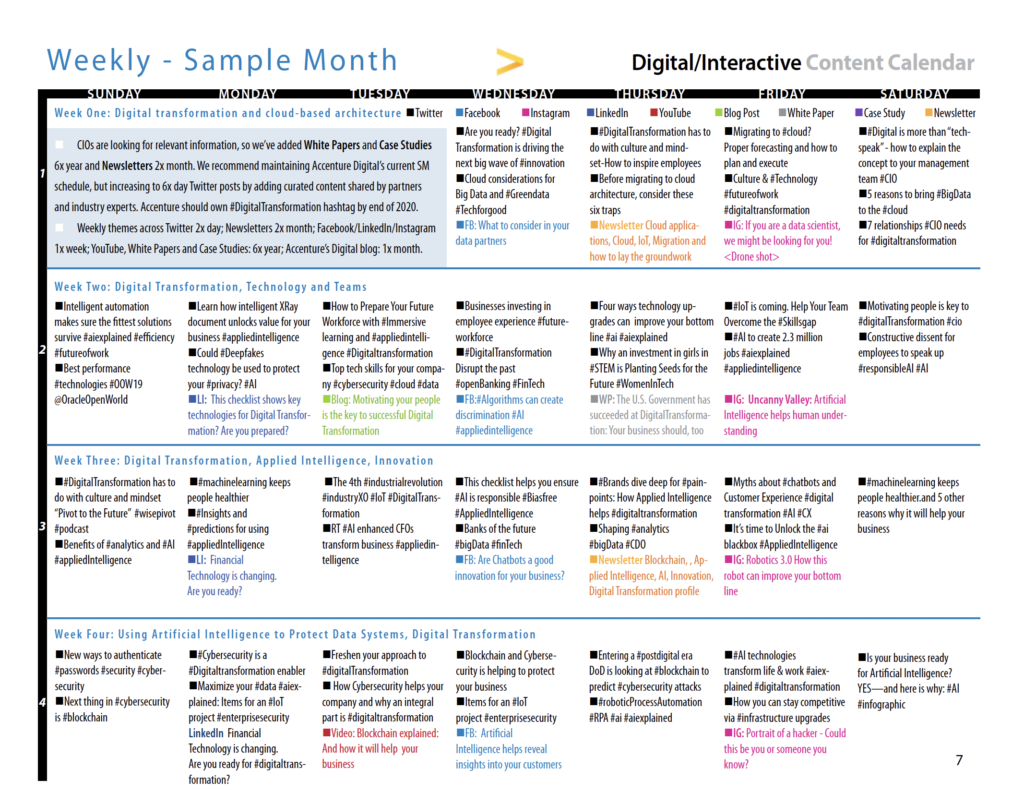 This sample indicates monthly and weekly which channels need content and touches on content themes.
This sample indicates monthly and weekly which channels need content and touches on content themes.
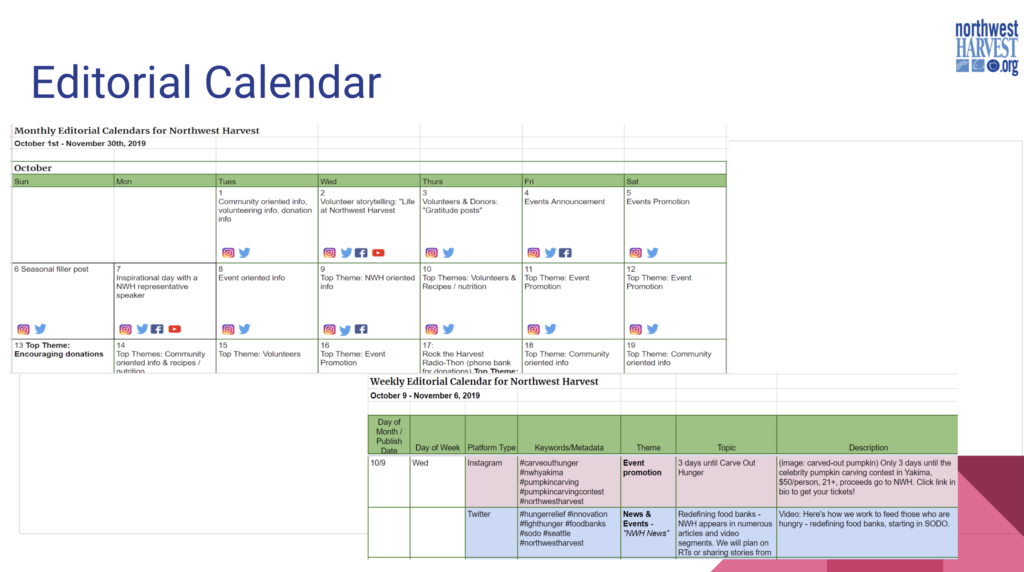 Managing your content
Managing your content
If your goal is to attract followers, knowing when and where to share a post makes sense. You want the best payoff for the time and energy you invest in creating or curating content. Apps and dashboards can help you use your time more efficiently.
Business accounts have access to detailed analytics, enabling businesses to gauge the value of the boosted posts or other paid advertising. The data reveals information about who is interacting with your content and when, where, and how. By looking at your content’s analytics, you can identify when your audience is most active.
There are tons of articles and resources on the web that offer time windows on various platforms. A terrific resource that shows when most users are active on various platforms and includes some recommendations broken down by industry can be found on this post by Sprout Social. Please check out the post for more detailed information.
Here are a few examples showing global engagement days and times.
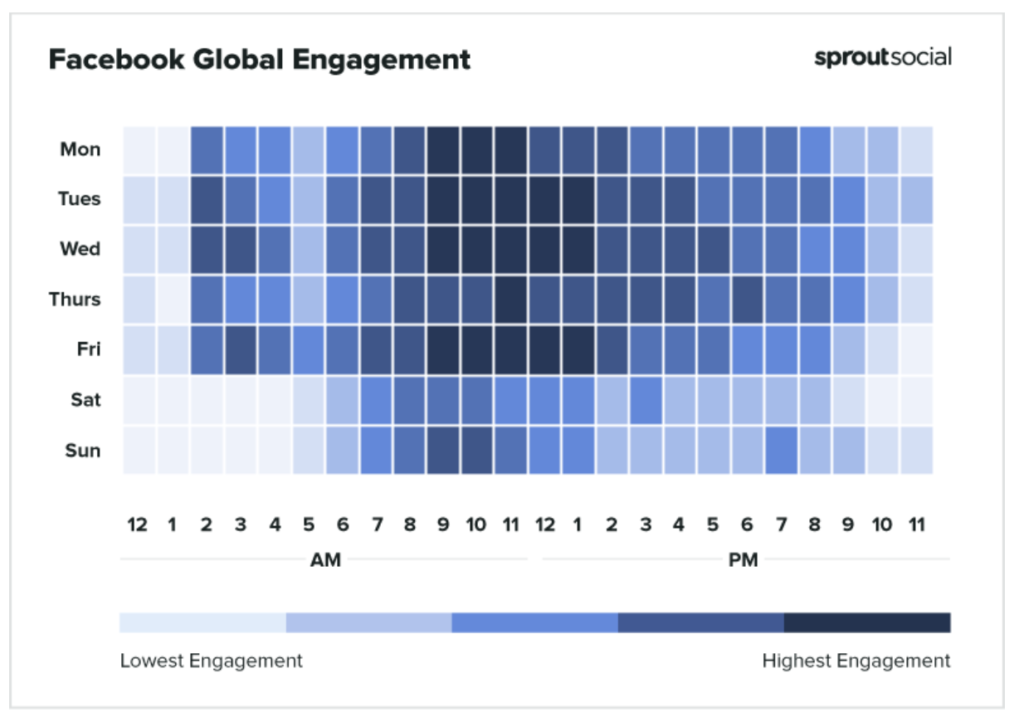
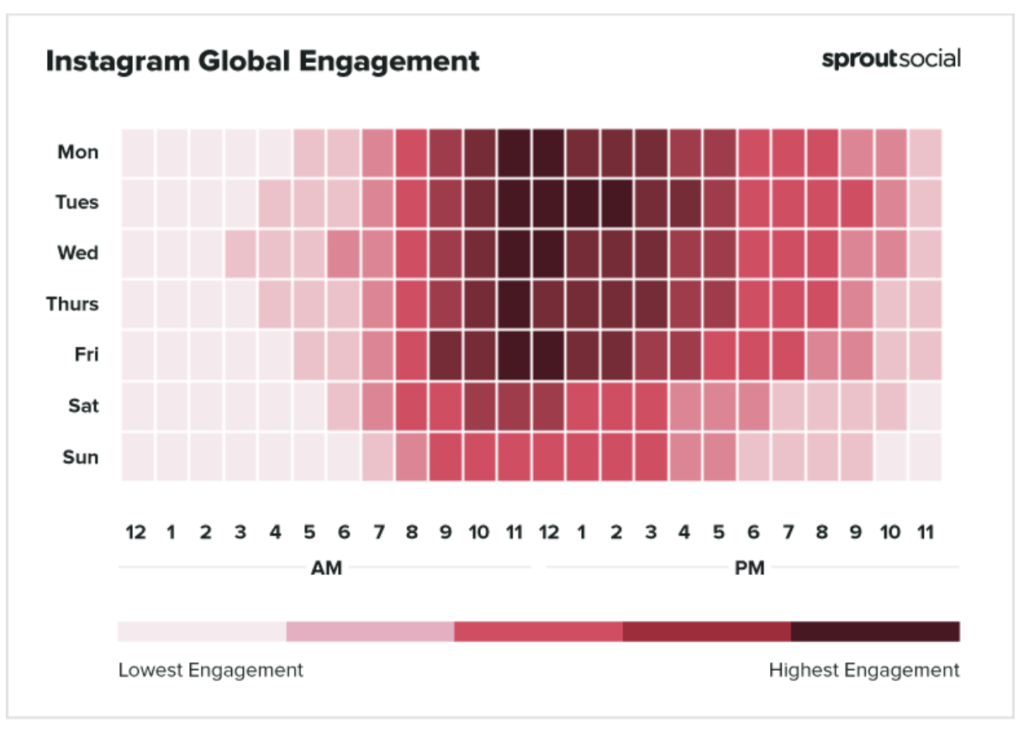
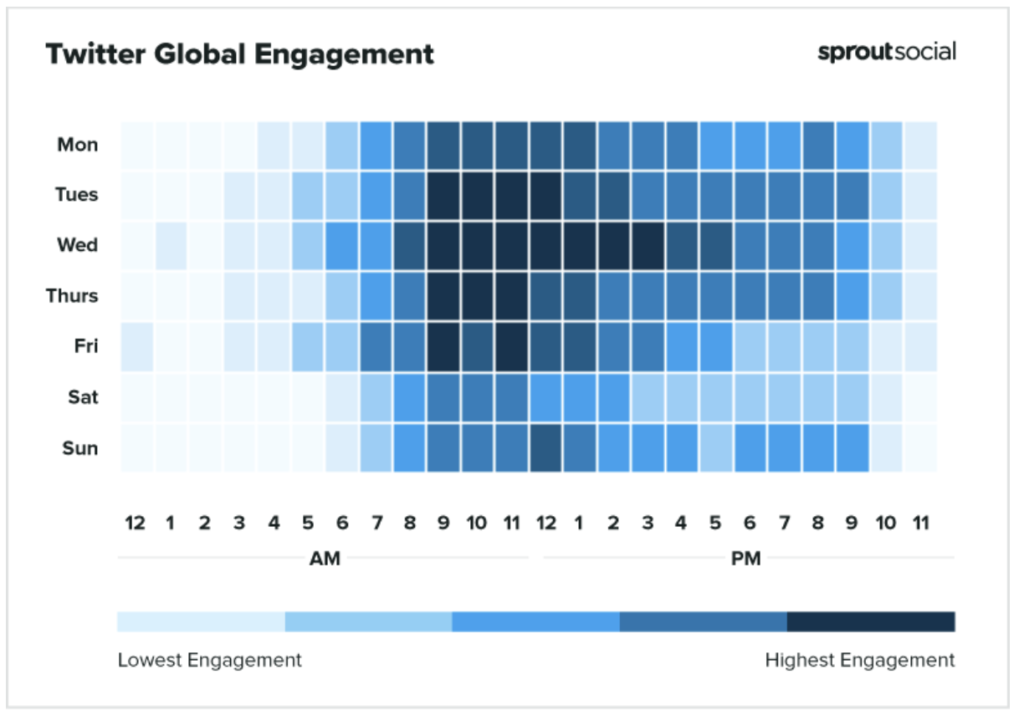
Companies benefit by using content tools, but do solopreneurs need them?
Even if you only focus on a single social media channel, it would still be beneficial to use a dashboard. The dashboard helps with scheduling, monitoring, and engagement. However, if you’re managing content on a few social channels, I urge you to check out a few dashboards to see what you like best.
Tweetdeck is a dashboard you can use with Twitter. It no longer has a scheduling feature, but it’s great for monitoring and engagement. You can set it up to see mentions or retweets and likes of your content. This tool enables you to focus on the people connecting with your feed and the best thing, it’s free!
Buffer is a visual dashboard and offers the channels and features I need, plus I’ve been a paying customer for 11 years. It’s powerful and lets me schedule across 8 social media platforms. The “Instagram Engagement” feature is worth its weight in gold. Also great , Buffer is now part of the Twitter toolbox, a relatively new suite of applications that help users make the most of their Twitter experience.
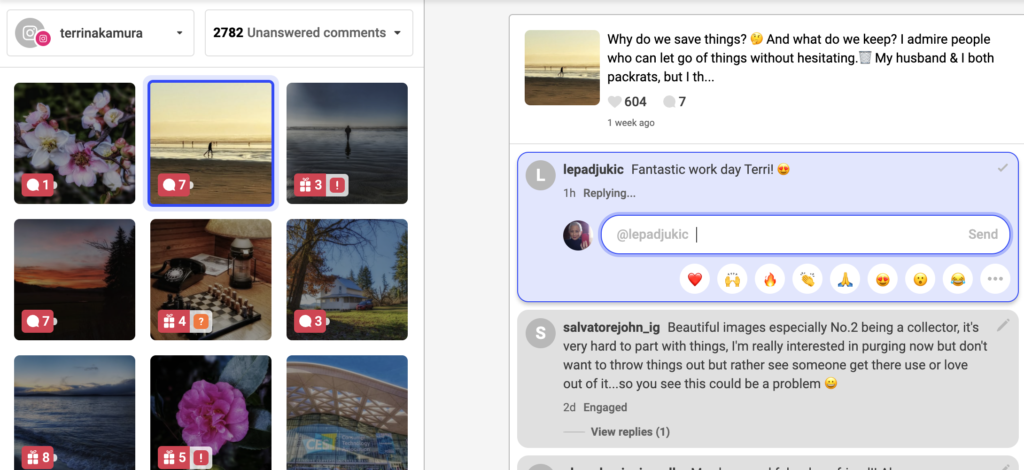
Dashboards enable you to customize content and schedule in one place. You can get a sense of what’s coming up and move things around and dashboards allow for spontaneity. For example, suppose a breaking story is happening right now. In that case, content can be created and published immediately or be designated to appear in the next scheduled time slot, or you can choose to post at a later date and time.
Do a test drive
I’m an individual user and post primarily to Twitter and Instagram. A photographer friend has found his most active community is on Facebook, so that’s where he focuses his energy. Two artist friends devote the most time to LinkedIn and have been tremendously successful there.

Each of us needs to identify the channels that will benefit us and the tools that will help us reach and interact with our audiences.
This is a lot to think about and many creative entrepreneurs don’t want to get bogged down with business tools. We would rather CREATE!
Content tools are worth considering because they streamline how we use our social media channels, making us more intelligent about what we do and hopefully giving us more time to do the stuff we love.
Content Tools
Buffer – publish, analyze, engage
Hootsuite — All-in-one dashboard
Later – Instagram marketing
Loomly – Publish, collaborate and measure
Sprout Social — Social media management
Tweetdeck – Twitter engagement and monitoring
More
Best times to post – Sprout Social
Calendar tools – Hubspot
Content Marketing Strategy
Microsoft – Blank calendars
*****
Guest author: Terri Nakamura is the owner of Nakamura Design + Social. She is a graphic designer, content creator, social media consultant, and the author of Blogging on Instagram: Engagement Writing on One of the World’s Best Social Media Platforms, available on Amazon and other online stores.







